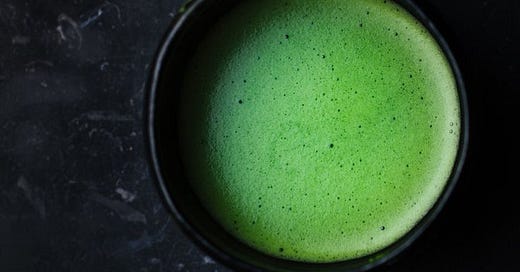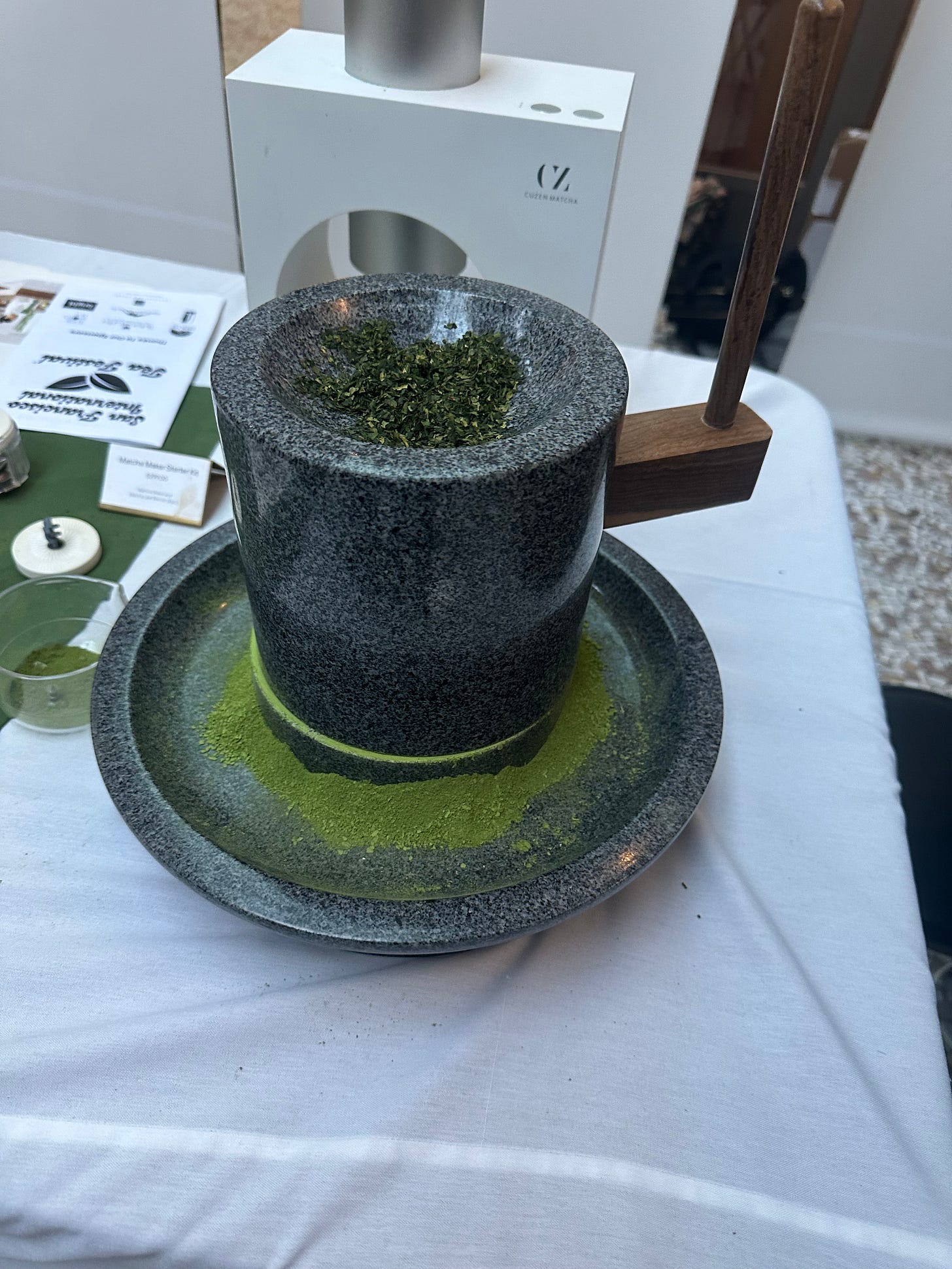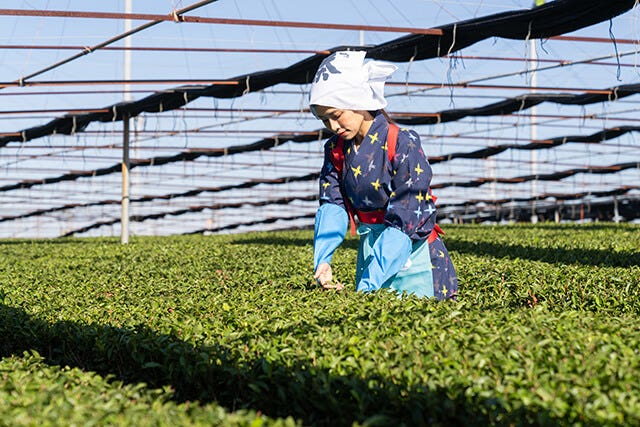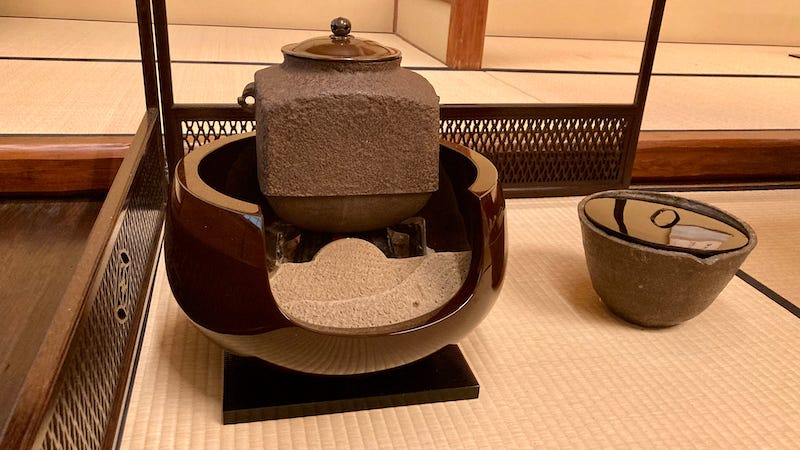Welcome back to Tea Tidbits! I know I said that we will be starting our journey to Laos soon but, today is February 6th which is known as National Matcha Day in Japan. Today I wanted to talk about matcha, my recommendations, how this holiday came to be and discuss some current news in the matcha world!
What is Matcha?
Matcha is a stone milled green tea that comes from the leaves of the tea plant, Camellia Sinensis. Before being stone milled, the leaves are called tencha.
Tencha leaves are fertilized three times in order to make the leaves sweeter and are then shaded for a minimum of 20 days. The shading period is why the best quality matcha’s are such a vibrant green. The leaves are then harvested and within 24 hours, they are steamed and air dried. The leaves then have their veins and stems removed, the flatter leaves are used for the best quality matcha. Tencha has the highest leaf quality which makes it the only tea eligible to make matcha out of.
Matcha History ~ a brief summary
When talking about Matcha, it is important to remember the history behind the Japanese tea ceremony and to pay respect where it is due. During the Tang Dynasty in China (7th-10th century) green tea’s were steamed, pulverized then mixed with salt and water and turned into “bricks”. This powdered green tea was then transported around China and during the Song dynasty (10th-13th century) this type of green tea was common. A Japanese buddhist monk by the name Eisai happened to be traveling china and brought this green powder back, he called it the “elixir of the immortals”. He also ended up bringing Camellia Sinensis seeds back to Japan and planting them all around Kyoto. In the 1500s a zen buddhist named Murata Juko created the principles that the Japanese tea ceremony still runs on, harmony, respect, purity, and tranquility.
~ if you want more information on the history behind Matcha, Japanese tea ceremonies, and tools, click here for my official deep dive~
History of National Matcha Day
This day was created by the Nishio Tea Industry Promotion Council in 1992 to celebrate the 120th anniversary of Nishio powdered green tea. One of Japan’s leading matcha producers is in the city of Nishio in Aichi Prefecture. Tea has been grown here, but specifically the producing of matcha took off during the Meiji era (late 19th century). Nishio now focuses on growing tea leaves for the production of Matcha. This date was chosen because of a play on words, the numbers 2 and 6 in Japanese sound like “furo” and furo refers to a traditional brazier (seen below) used to heat water in order to make Matcha.
Current News ~ The Shortage of Matcha
Matcha has now become scare thanks to social media, in Japan there are signs in supermarkets that warn customers of how difficult times are to find matcha. There are claims that customers have been spotted purchasing around 20 tins of matcha at once.
In autumn of 2024 there were rumors of a matcha shortage which were circulating globally. This is important since matcha’s unique quality is that tencha is only harvested once a year in April or May. It is quite normal for the matcha reserves to dwindle during winter, but this was different and the Global Japanese Tea Association was puzzled by the new buzz from the international community. The rise of tea consumption, specifically Matcha can be seen on tiktok where the niche #matchatok has rounded up over 40,000 posts!
So, What Happened?
Over the last decade, exports of Japanese tea have increased rapidly, this mixed with the influx of tourism since after COVID-19 has hit the matcha market. Not to mention, Japan’s matcha prices are exponentially cheaper then those anywhere in the West. Climate change over the last century has created unpredictable weather that impacts the quality and quantity of the tea leaves. Matcha is unique, because of it’s harvest that happens only once in spring but also because matcha takes up only 6% of Japan’s tea production. Most Japanese tea farms are small and family owned, they stick to traditions such as granite stone mills which limit production amounts. Grinding matcha with a mill is an extremely slow process as the stone mill can only create 40 grams of matcha per hour. #Matchatok and other matcha trends have created challenges for farmers who are struggling to meet the matcha demands. There have been some shortages at several matcha producers mainly in Uji, Japan. Surplus of tencha can be stored in fridges for a while, this year’s demand has almost depleted the existing stocks. Tencha is also ground gradually and not all at once but when the demands spiked, the milling of tencha could not keep up. Which is why this year, the Ministry of Agriculture, Forestry, and Fisheries in Japan is encouraging a higher yield of tencha rather than the other types of tea. Since 2000, matcha sales have hit a whopping 10 billion dollars in the USA. In 2023, Japanese tea exports reached a high of 2.92 billion yen. It is estimated that the matcha market will grow to 5 billion yen by 2028.
What companies have been most affected?
Many amazing brands have been effected by this but Marukyu Koyamen sold out of all their matcha products which were offered on the companies international online shop for the first time ever. Ippodo is another brand that was almost completely wiped out of matcha products from their online store. One of my all time favorite tea companies, Kettl, and their owner Zack Mangan spoke to the New York Post and told them that he did almost 6 months worth of sales in under a month.
How will they combat this issue?
Brands have started to combat this issue as on September 5th 2024, Ippodo announced a price increase for all their matcha products. Marukyu Koyamen followed in October with a price raise also. Specialty stores in Tokyo have started to limit the matcha item purchases to 1 item per person. Cafe’s in Sydney, Australia have started to put purchase limits on matcha items. Businesses in Singapore have also started to implement a 15% price increase on all matcha products as of mid October 2024. Kettl’s owner, Zack Mangan talked to Eater and told them that the current demand in matcha will lead to changes in how matcha is priced and allocated but he feels confident that Kettl will do fine.
All the Matcha’s I tried in 2024 & my personal opinions:
Rocky’s Matcha Ceremonial Blend ~ A trusty blend that is great for beginners as it isn’t astringent, its nice, creamy and perfectly balanced.
Rocky’s Matcha Single Cultivar Gokou ~ I would recommend this for anyone, this matcha lies in my top 3. It is sweet and delicate but such a special and unique matcha.
Rocky’s Matcha Single Cultivar Asahi ~ I would recommend this for a slightly more advanced matcha enjoyer, it is a bit astringent and leans umami.
Rocky’s Matcha x OTTO958 Oishi ~ This one was a great, smooth matcha and I found myself leaning to it when I wanted to make a matcha latte.
Marukyu Koyamen Aoarashi ~ This was a good matcha but it was not super complex or deep in flavor. I had a good experience trying this but I personally would not repurchase.
Marukyu Koyamen Chigi No Shiro ~ This has a fun banana smell when you open the tin lol! A greater starter or advanced matcha, perfectly balanced with little bitterness. It is slightly umami but it works great!
Marukyu Koyamen Kinrin ~ Personally, I found this one highly astringent and I did not lean towards using this.
Kettl Hanaka ~ I liked this one, I found it a little astringent but not in an unpleasant way, it tasted creamy and nutty.
Kettl Shirakawa Legacy Blend ~ An absolute 10/10, I would recommend this for a more experienced matcha drinker because of how complex it is but I also would recommend this to a new matcha enjoyer just because of how amazing it is but it does have a steeper price tag!
Ippodo Ikuyo ~ A good matcha, I would recommend this if you are just starting to get into matcha!
Ippodo Premium Select ~ This was an amazing matcha, it was very rich and luxurious. This matcha is super interesting because it changes every year which allows you to try a different favorite from Ippodo.
Tea Dealers Shousui ~ A complex matcha that was fresh but sweet, one of my top matcha’s!
~Personally, I don’t recommend buying Matcha in bulk as it’s stone milled which can cause oxidation, try to plan for maybe 3 months worth and storing in the fridge can elongate your matcha’s lifespan~
This was such a fun deep dive for me! Let me know what you all think of this news and if you have heard of it before!? Thank you all for tuning in today, Thursday’s are not my usual post days but this week was special because of this holiday! Tomorrow, I will be sending out your introduction to the tea world in Laos!











This was a fantastic read!